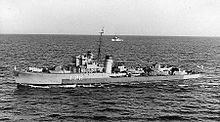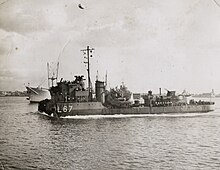Adriatic (L67)
|
The heavily damaged Adriatic Sea on the march to Alexandria
|
||||||||||||||||||||||
|
||||||||||||||||||||||
|
||||||||||||||||||||||
|
||||||||||||||||||||||
|
||||||||||||||||||||||
The Adria (L67) of the Royal Greek Navy was a destroyer escort the British Hunt Class of type III , which for the British Royal Navy had been built. The ship was commissioned by the Greek Navy in 1942 as the second ship of this type and used under British command.
The Adrias ran into a mine near the island of Kalymnos on October 22, 1943 , which tore down the forecastle. She escaped to the Turkish coastal waters and was able to return to Alexandria by December 6, 1943 after an emergency repair without a bow. A comprehensive repair of the ship did not take place because of the sea war development in the Mediterranean Sea and in 1945 the ship was demolished.
History of the ship
The ship was ordered as a destroyer escort on August 23, 1940 as part of the British war budget of 1940 at Swan Hunter in Wallsend along with other Type III ships of the Hunt class. The shipyard was the main supplier of these escort destroyers with sixteen ships of types I, II and III built. The keel of the 14th order with construction number 1645 took place on May 1, 1941 and it was launched as Border on February 3, 1942. In 1942 the Royal Navy had difficulties manning its ships and therefore gave ships to the Allied navies. This procedure had already started in May 1940 when the destroyer Garland was made available to the Polish Navy. The British decided to lend the Greeks four new Hunt destroyers, which came into service under the Greek flag as Adrias , Kanaris (ex-Hatherleigh), Miaoulis (ex-Modbury) and Pindos (ex-Bolebroke). Three newbuildings came from Swan Hunter in Wallsend and the fourth ship from the neighboring High Walker shipyard in Vickers-Armstrong , so that the Greeks only had to form an acceptance and training command in Newcastle .
As the second ship, the Border was put into service on August 5, 1942 as Adrias , which had been taken over by the Greek Navy during the final equipment in July. The ship was named after the old Greek settlement Adria (Veneto) , which is said to have given its name to the Adriatic after Greek historians .
Calls
During the training phase with the Home Fleet , the Adrias ran aground on August 26, 1942 in the fog near Scapa Flow when only one machine was working. The Greek commander was not responsible for the damage, which took over four months to repair. So the Adrias could not begin its transfer into the Mediterranean until January 1943. The relocation took the ship around Africa in over two months. In the Mediterranean, she soon moved to Algiers with the other Greek destroyer escorts in preparation for the Allied landings. At the beginning of July 1943 she belonged with Pindos , Kanaris and Miaoulis to the security units of the Allied landing on the south and south-east coast of Sicily ( Operation Husky ).
When Italy signed an armistice with Great Britain and the United States, the Italian fleet had to be handed over to the Allies in September 1943. The battleships Caio Duilio and Andrea Doria ran from Taranto to Malta, where they were escorted by the British battleship King George V and other units, which included the Adriatic as a representative of Greece .
In September the Adrias was also used to support British operations in the Dodecanese . On October 22, 1943, the destroyers Jervis and Pathfinder ran with supplies and reinforcements from Alexandria to Leros. The cargo and the reinforcements could not be unloaded immediately due to German air raids and the unloading had to be done with barges in Alinda Bay. On the 23rd, the two destroyers of the fleet were able to march back. With the two destroyers, the escort destroyers Adrias and Hurworth (Type Hunt II) had gone to sea, which should carry out a diversionary attack. They had spent the night near Kos and on the evening of the 22nd were looking for German transporters or were supposed to bombard land targets on Kos, which was again occupied by the Germans.
The Greek Adriatic ran south of Leros and between the island of Kalymnos and the Turkish mainland on a mine, the explosion of which tore off the forecastle and threw the bow gun into the bridge, and caused considerable personnel losses. The British commander of the gang assumed a loss of the ship and tried to hide the crew with the Hurworth , under his command . He came across another mine, which broke the Hurworth in two parts. The forecastle sank within three minutes and the burning stern section after a further fifteen minutes at position 36 ° 59 'N, 27 ° 6' E. 113 men died when the British destroyer escorted. The Adrias , which continues to swim , was able to save 85 castaways, including the commander. On the Greek destroyer, 21 people were killed and another 30 men were injured, some seriously. The Greek commander was able to reach the neutral Turkish coast near Gümüşlük with his badly damaged ship , where the dead were buried.
Both Hunt destroyers were on a east of Kalymnos straight from the German minelayer Dragon (the built in Germany, former Yugoslav Tender Zmaj get laid) Mine barrier that even the destroyer the following day Eclipse at the other end was the undoing of that with 119 crew members and 134 soldiers transported on the ship went down. The petard accompanying them was able to take 42 castaways on board.
The commander of the Adrias tried with the limited resources available to prepare his ship for a transfer. He had the front bulkheads reinforced with wood and concrete. Despite the Turkish guard, this was possible and there was also contact with the development outside, as the British regularly used the Turkish coastal waters for their advances. At the end of November, the Jervis replaced the previous army crew on the small island of Kastelorizo immediately off the Turkish coast south of Rhodes with a commando unit that, if necessary, was supposed to pretend to be members of a non-belligerent state. The first stage of the return of the Adriatic should go up to there. On December 1, the severely damaged destroyer began its return voyage without a bug. The ship was controlled from a rear auxiliary station, as the bridge was also unusable after the mine hit and its facilities did not work. At night the Adrias left Gümüşlük under the guidance of three British motor boats, one of which led the destroyer with the stern light. The Turks did not hinder the departure. The journey was then continued on its own during the day. No further night trips were made because the destroyer did not have its own navigation aids at night.
Before Kastelorizo, the destroyers Jervis and Penn picked up the damaged ship and escorted it to the small island, where they waited for a tug. On December 3, the naval tug Brigand arrived, who was supposed to tow the distressed vessel. Under the protection of the two destroyers, the tugboat then continued its journey to the British base in Limassol on Cyprus . Towing turned out to be considerably more strenuous than driving his own machine, so the commander decided on a final crossing of the Mediterranean towards Egypt on his own. On the 4th he continued the voyage without the assistance of a tug at a low speed under the protection of the two destroyers.
At sea, on December 5, the two Hunt destroyers Exmoor (II) and Aldenham took over the protection of the Adrias, which entered Alexandria on December 6, 1943 to the applause of the Mediterranean fleet with eight knots. The commander was considered to be an excellent example of the Greek navy's will to resist and its technical ability.
Further use
When the Germans began to evacuate Greece in the autumn of 1944, the Adrias only had a makeshift bow. As a symbol of the fleet because of its spectacular crossing and participation in the surrender of the Italian fleet, it was transferred with the Greek fleet to the Faliro naval base . Because of the extensive end of sea warfare in the Mediterranean, it was never fully repaired. As a loan, she was transferred to Great Britain in 1945 and returned to the Royal Navy. This classified the Adrias as a total loss and sold it for demolition.
As a replacement, the Greek Navy received a new Adrias (DO6) with the former HMS Tanatside in 1946 . This Hunt III destroyer, completed by Yarrow in 1942, had distinguished itself during World War II in the Atlantic, the English Channel, the Normandy and Biscay landings and was made available on loan from Great Britain. It was not until August 1962 that the second Adrias retired as the penultimate Hunt destroyer from the service of the Greek Navy and was scrapped in Greece from 1964.
It was not until 1994 that the name was used again in the Greek fleet with the standard frigate Adrias (F459).
Individual evidence
- ^ Hellenic Navy General Staff website
- ^ Rohwer: Chronicle of the naval war. P. 393.
- ↑ some sources name 143 dead
- ↑ The dead were later transferred to Greece.
literature
- HT Lenton: Warships of the British and Commonwealth Navies. Ian Allan, 1969.
- Antony Preston: Destroyers. Hamlyn, ISBN 0-60032955-0 .
- Jürgen Rohwer , Gerhard Hümmelchen : Chronicle of the naval war 1939-1945. Manfred Pawlak Verlag, Herrsching 1968, ISBN 3-88199-009-7 .





